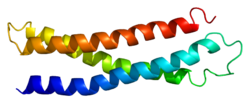Sandbox Reserved 482
From Proteopedia
| Line 14: | Line 14: | ||
Syntaxin-1A is part of the SNARE (soluble N-ethylmaleimide-sensitive factor attachment protein receptor) family. It is an integrin plasma membrane protein found almost exclusively in neurons and it is known for its essential roles in neuronal signaling. (1) It assembles in tight core complexes, which promote fusion of carrier vesicles with target compartments. Members of the SNARE class of proteins are expressed in all eukaryotic cells and are distributed in distinct subcellular compartments. (2) | Syntaxin-1A is part of the SNARE (soluble N-ethylmaleimide-sensitive factor attachment protein receptor) family. It is an integrin plasma membrane protein found almost exclusively in neurons and it is known for its essential roles in neuronal signaling. (1) It assembles in tight core complexes, which promote fusion of carrier vesicles with target compartments. Members of the SNARE class of proteins are expressed in all eukaryotic cells and are distributed in distinct subcellular compartments. (2) | ||
| + | |||
The neurodevelopmental disorder Williams syndrome is caused by the haploinsufficiency of genes. It is caused by deletion of genetic material. The deleted region has now been identified and syntaxin-1A is one of the genes that has been deleted. (3) | The neurodevelopmental disorder Williams syndrome is caused by the haploinsufficiency of genes. It is caused by deletion of genetic material. The deleted region has now been identified and syntaxin-1A is one of the genes that has been deleted. (3) | ||
| Line 21: | Line 22: | ||
---- | ---- | ||
| + | |||
| + | NMR spectroscopy was used to identify a folded N-terminal domain in Syntaxin-1A and to determine its three-dimensional structure. This 120 residue N-terminal domain is conserved in plasma membrane syntaxins. The domain is made up from three long alpha helices and an up-and-down bundle with a left-handed twist. (4) | ||
| + | |||
| + | |||
| + | Syntaxin-1A has 288 residues. Residue 1-265 make up the cytoplasmic domain and residue 266-288 form the carboxyl-terminal transmembrane anchor. It adapts a well-folded tertiary structure with repeated hydrophobic residues forming a colied coil structure. (5) | ||
| + | |||
'''Function''' | '''Function''' | ||
Revision as of 18:51, 28 April 2012
| This Sandbox is Reserved from 13/03/2012, through 01/06/2012 for use in the course "Proteins and Molecular Mechanisms" taught by Robert B. Rose at the North Carolina State University, Raleigh, NC USA. This reservation includes Sandbox Reserved 451 through Sandbox Reserved 500. | ||||||
To get started:
More help: Help:Editing For more help, look at this link: http://www.proteopedia.org/wiki/index.php/Help:Getting_Started_in_Proteopedia
Syntaxin-1AIntroduction Syntaxin-1A is part of the SNARE (soluble N-ethylmaleimide-sensitive factor attachment protein receptor) family. It is an integrin plasma membrane protein found almost exclusively in neurons and it is known for its essential roles in neuronal signaling. (1) It assembles in tight core complexes, which promote fusion of carrier vesicles with target compartments. Members of the SNARE class of proteins are expressed in all eukaryotic cells and are distributed in distinct subcellular compartments. (2)
NMR spectroscopy was used to identify a folded N-terminal domain in Syntaxin-1A and to determine its three-dimensional structure. This 120 residue N-terminal domain is conserved in plasma membrane syntaxins. The domain is made up from three long alpha helices and an up-and-down bundle with a left-handed twist. (4)
Applications |

